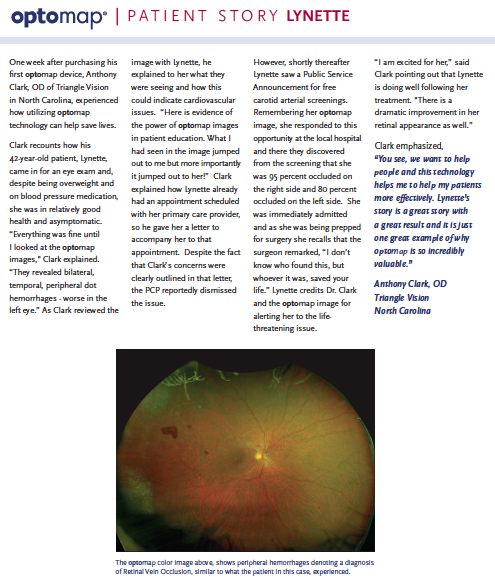April Is Women’s Eye Health and Safety Month
Prevent Blindness has designated April as Women’s Eye Health and Safety Month. The entire month is dedicated to women’s eye health in recognition of the ~3 million American women who suffer from vision impairment or blindness.

The optomap color image above, shows peripheral hemorrhages denoting a diagnosis of Retinal Vein Occlusion, similar to what the patient in this case, experienced.
Many women neglect their own health needs, focusing instead on the health and wellness of their loved ones. This leaves many women vulnerable to undetected health issues, and as with other health conditions, the earlier an eye problem is detected, the better the chances are for treatment and recovery.
Regular and prophylactic health care is important for earlier detection of all health issues. Because the retina is the only place in the body where vasculature can be seen, non-invasively and because optomap captures 200 degrees of the retina in a single image, more ocular and non-ocular disease can often be detected, earlier. Therefore, we recommend to all eyecare professionals, that their female patients, especially those over age 40, include optomap as part of their comprehensive eye exam.
The following patient story illustrates how powerful optomap images are for patient education and care:
Lynette, 42 years old, came in for a routine eye exam. Her eye doctor, Dr. Anthony Clark, OD, from North Carolina’s Triangle Vision, had recently purchased his first optomap device. Although she was on blood pressure medication and overweight, Lynette seemed to be in good health.
Dr. Clark explained that everything seemed fine until he reviewed the optomap images. The images revealed temporal, bilateral, and peripheral dot hemorrhages in Lynette’s left eye. He explained to Lynette the details of the image and told her that what they were looking at could be an indication of cardiovascular problems.
Since Lynette had an appointment already scheduled with her primary care physician, Dr. Clark gave her a letter to bring with her. Lynette’s primary care physician ignored the issue, despite the concerns outlined in the letter.
Shortly after, Lynette noticed a public service announcement that reported the availability of free carotid artery screenings. She immediately responded to this announcement, remembering her optomap image and Dr. Clark explaining the possibility of her having cardiovascular problems.
The screening revealed that Lynette had up to a 95 percent and 80 percent occlusion on the right and left sides of her heart, respectively. Immediately, the medical staff admitted her to the hospital and prepared her for surgery.
The surgeon told Lynette, “I don’t know who found this, but whoever it was saved your life.” Lynette credits the optomap image and Dr. Clark for alerting her to this life-threatening issue.
Lynette’s story highlights the importance of including optomap as a part of a comprehensive eye exam for overall health and wellness. Put optomap in your practice today!